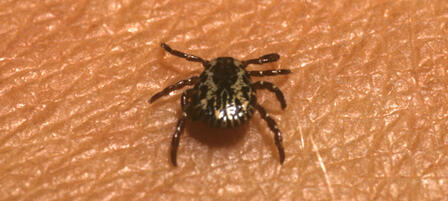Take Tick Prevention Seriously

PRATT – They’re creepy-crawly, blood-sucking arachnids; nobody likes ticks. Unfortunately, they are a fact of outdoor life in Kansas. But you don’t have to stay indoors to protect yourself. There are some precautions you can take to ensure ticks dislike you as much as you dislike them.
Tick numbers usually peak in early June, but depending on spring temperatures, they can be common from April through July. And protecting yourself is serious business because they can spread dangerous blood-borne diseases such as Rocky Mountain spotted fever and Lyme disease.
To make yourself as tick proof as possible, start by wearing light-colored clothing with long sleeves and pants. Keep pantlegs tucked into your socks. Do periodic checks and be sure to examine yourself and your clothing after an outing.
Use a repellent. Most people who spend time outdoors are familiar with the ingredient DEET, contained in many commercial insect repellents. It can be sprayed directly on your skin, and repellents that contain 20 percent to 30 percent DEET will repel ticks for several hours. Permethrin is another option. Unlike DEET, which repels ticks, permethrin causes muscle spasms, paralysis, and death for ticks if they touch it or consume it. Because of its potency, permethrin can only be applied to clothing. Permethrin-based products currently on the market can also last up to six washes, making a bottle go a long way.
Permethrin-based sprays can be purchased at most major retailers and are roughly the same price as popular repellents containing DEET. Look for a spray that contains at least 0.5 percent of permethrin. Clothing pre-treated with permethrin is also available.
When treating clothing with permethrin, be sure to read the instructions carefully. Apply the spray in a well-ventilated area, or outside. Then, let clothes air-dry by hanging them on a line or by leaving them out on a porch or outdoor table. Once dry, the treated clothing can be worn immediately.
Self-checks are important. It can take up to 36 hours for a tick to infect you if it attaches, so prompt removal is critical. If you find one attached, the best way to remove it is to grasp it gently close to the skin with tweezers and pull steadily straight up. Other methods may cause the tick to expel saliva and increase the chance of infection. Watch the bite site for signs of redness or a “bullseye” rash, which can be a symptom of Lyme disease. If you experience aches and pains or other flu-like symptoms after a tick bite, see your doctor as soon as possible. Early treatment is important.
Don’t let an insect just larger than the head of a pin keep you inside this spring. Follow basic precautions and enjoy the best time to be outdoors in Kansas.
-30-









